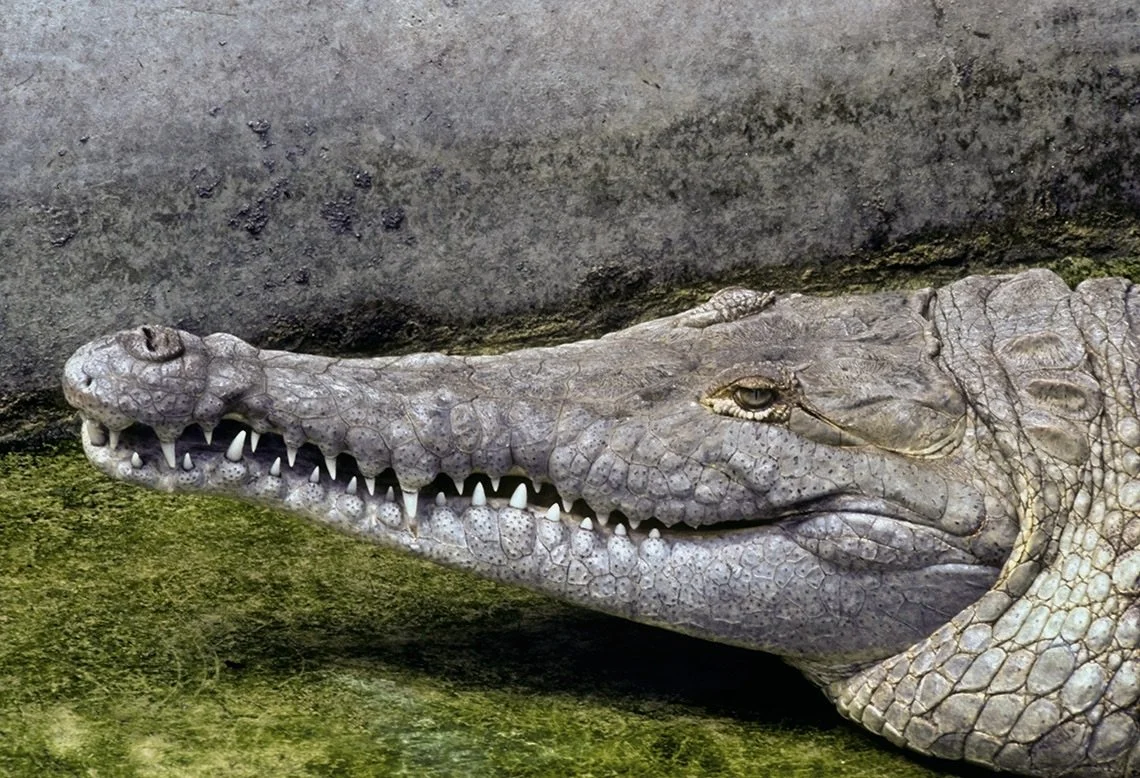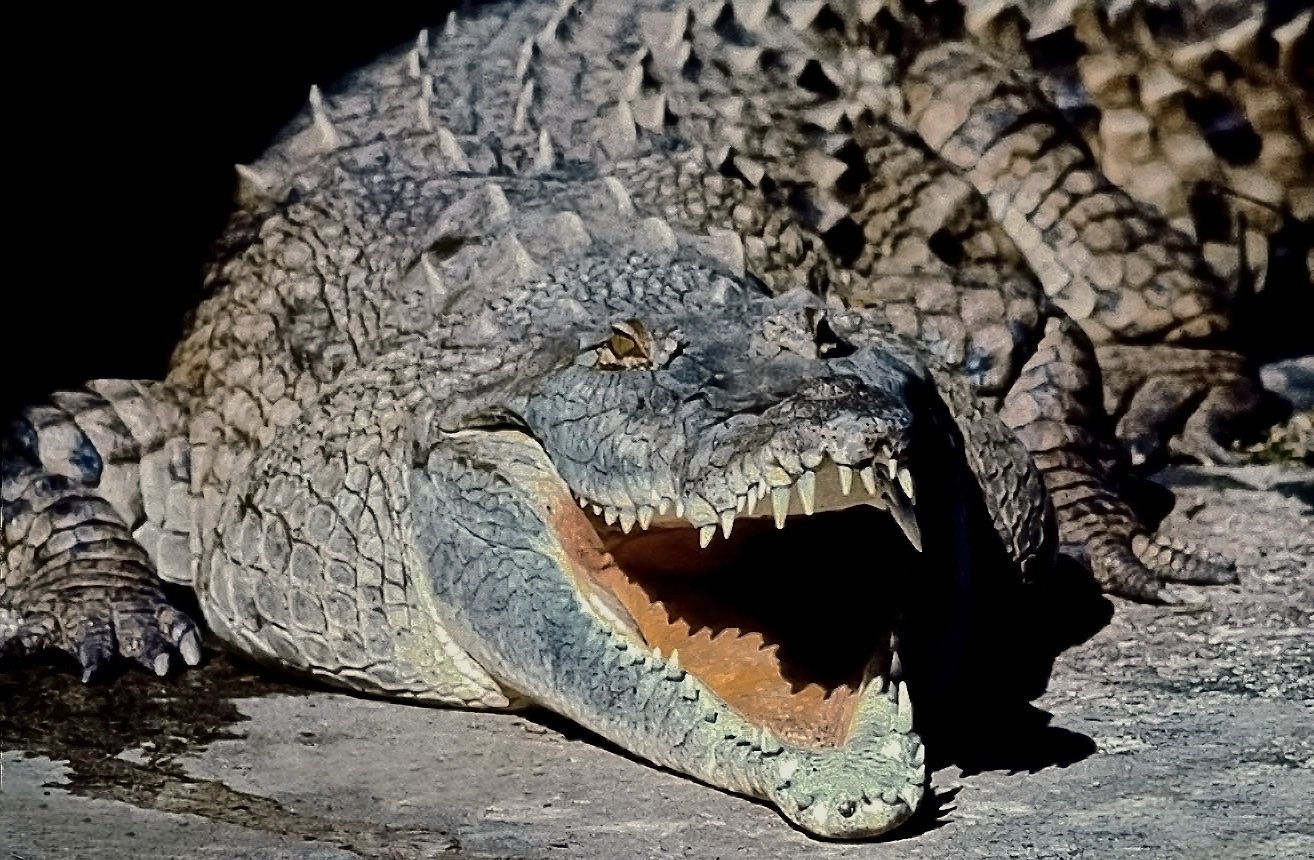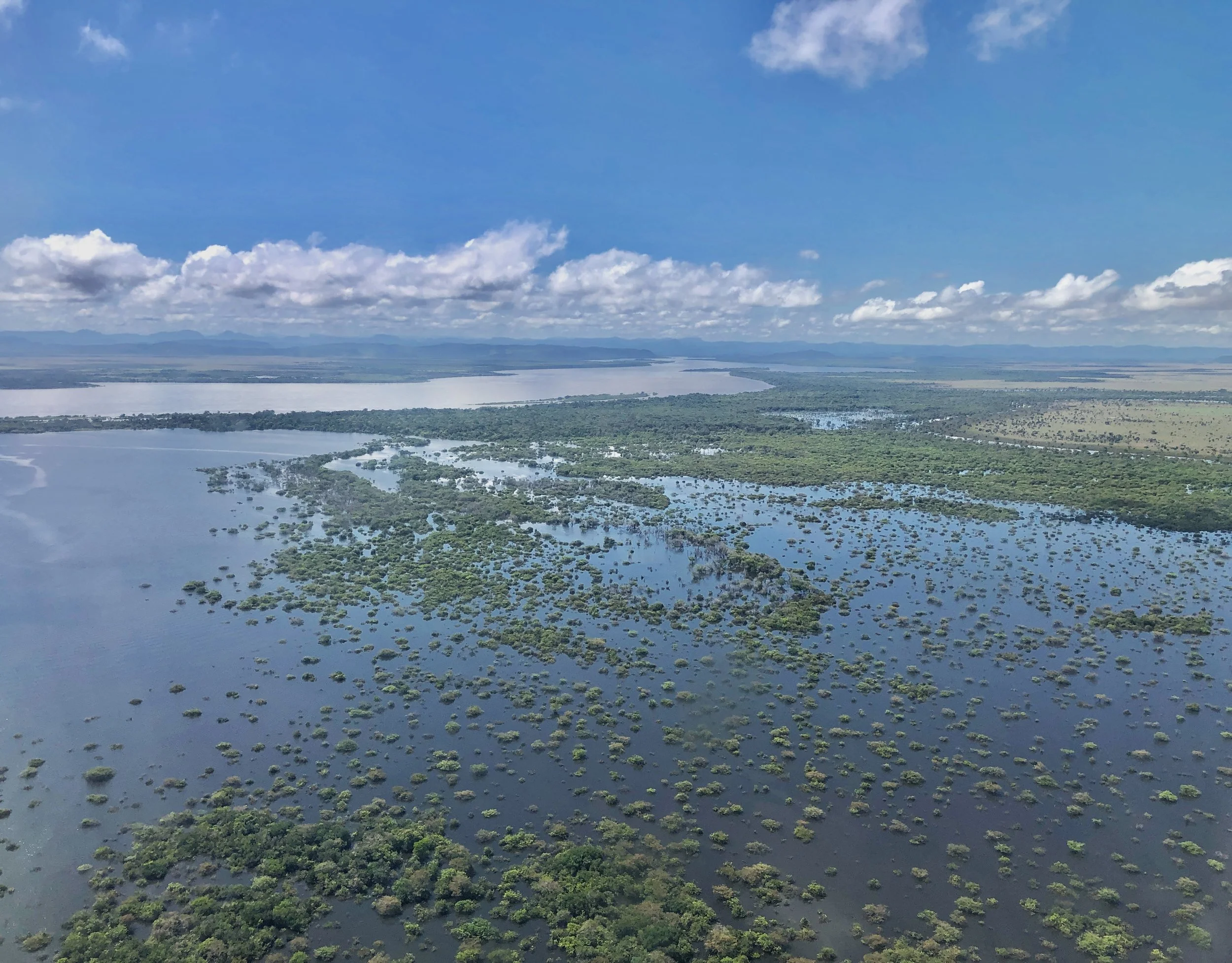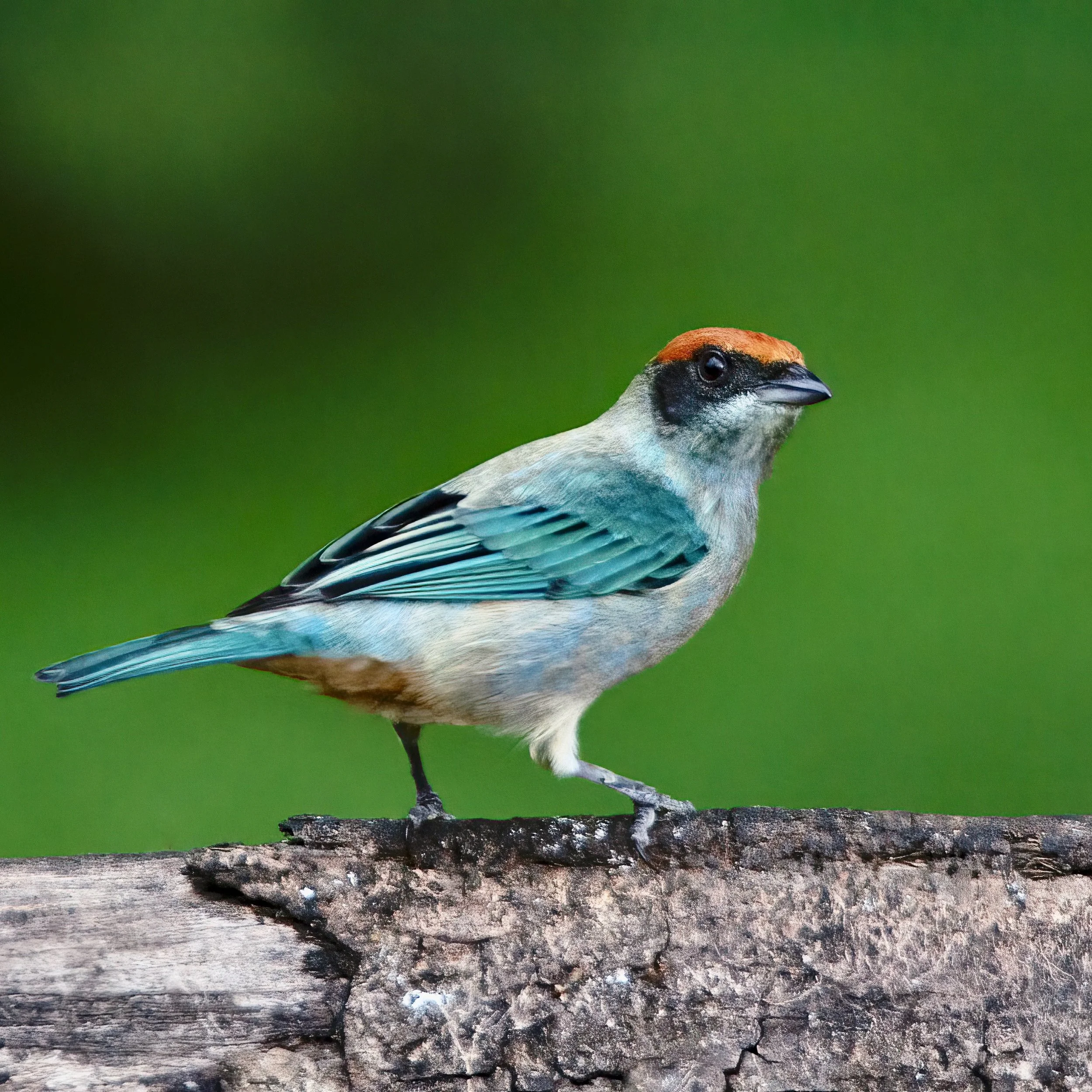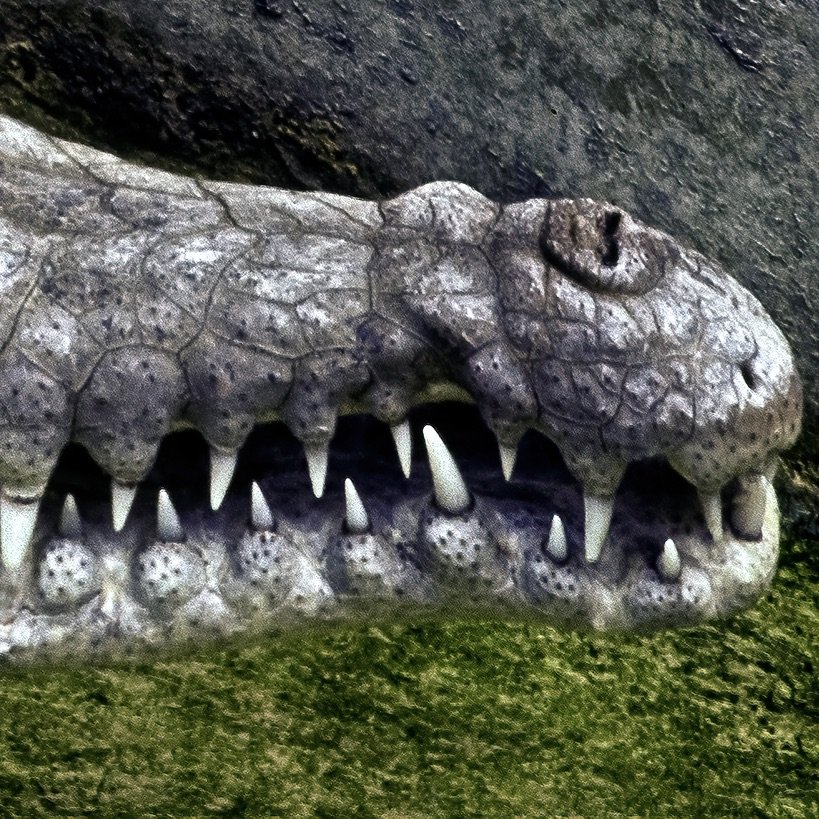Orinoco Loco
Guess who’s coming for breakfast?
By William W. Lamar
Any crocodile in captivity has a perfect right to be in a bad mood. After all, no matter how good the housing, or how great the care, they’d obviously rather be swimming in a river or lagoon or lolling in the mud under tropical sunshine.
Not that life in the wild once humans entered the picture is everything it’s chalked up to be.
When I worked as a research associate with Dr. Federico Medem at the Roberto Franco Biological Station in Villavicencio, Colombia, all the country’s crocodylians – four caiman and two crocodile species – were in jeopardy (they still are). Habitat alteration and encroachment coupled with uncontrolled hunting were (and are still) doing a number on the scaly critters. But the major blow had come much earlier, during the period when the rapacious hide industry’s appetite for crocodylian leather led to a slaughter that we would term genocide if the reptiles walked on two legs. While I was working there, back in the 1970s, INDERENA, Colombia’s department of the interior, authorized an annual harvest of 290,000 caiman hides. Since this absurd figure was likely in excess of the country’s estimated entire population of these beasts at the time, Medem was forced to convene a press conference and call them out. Fortunately, this intervention was successful. Sadly, the decimation simply continued at a somewhat slower pace until recently.
Jack Joy, former General Curator at Dallas Zoo, poses in 1979 with the skull of an enormous Orinoco Crocodile then in the collection of Dr. Federico Medem. While few crocodylians anywhere attain the incredible proportions they did in the past, there are still large animals out there. Skull dimensions support the estimate that this animal was in the 20’/6.15 m size range in life. Image: ©W. W. Lamar 2022
In the world of notorious wildlife, the Orinoco Crocodile (Crocodylus intermedius) has always flown a bit under the radar. Perhaps Nile crocs, Salties and Gharials have better agents. The Orinoco, known in Colombia and Venezuela as Caimán Llanero, is certainly one of the world’s largest crocodylians. Most notably, one of renowned explorer Alexander von Humboldt’s expedition companions measured one more than twenty-two feet long in the early 19th century. Of course, little in our shrinking world survives long enough to reach such a size these days. These charismatic and endangered beasts are restricted to a handful of rivers in the Orinoco River drainage system of Colombia and Venezuela. Medem, who was the leading authority on all things turtle and crocodylian, kept a bevy of Orinocos on premises at the station to gather data about their growth, behavior, and with any luck, reproduction. Among my duties over the years was censusing the few remaining Orinoco crocs in the wild and wrangling in the occasional live specimen for the captive breeding project.
To understand the drama of this story requires a little setting of the scene: The biological station where I worked is a large area, entirely behind walls. Its two principal buildings are long and rectangular, set parallel to one another and accessed at either end, like giant shotgun houses. The station office was in the near end of one building and my office was in the near end of the other. More walls enclose the somewhat narrow space between them. The far ends of the two buildings form part of yet another walled off section containing all the turtle and crocodylian pools. Inside the buildings were a series of large rooms, some accommodating incubators, cages, lab equipment, and bookcases; others filled with counters and chairs for work.
Now that I think about it, the station was sort of a maze.
We had a couple of large Orinoco crocs, ponderous brutes, each over ten feet of muscle and armor; that were housed individually. One lived in a spacious, walled pool with a generous portion of land to one side. This particular croc was relatively easy going, although I quickly learned to never take my eyes off him when I was in the enclosure. They always know when you’re looking at them…and when you’re not. The larger animal lived in that walled-off rectangular space between the two buildings. This meant that his lounging area was considerably smaller than that of his nearby companion. And home, sweet home was a long, rather narrow cement trough of water in the middle with an incline at one end. Adequate but by no means ideal, this perhaps explained why the big croc seemed to be perpetually in a bad mood; the place cramped his style. Simón, one of the fellows tasked with his care, suffered several narrow escapes during cage cleaning. Once, at the last minute, he employed a PVC drainpipe to fend off unwanted attention. Simón made it, but the pipe was left in shreds.
A recent study* established that, together with American Crocodiles (Crocodylus acutus), Orinocos possess the strongest bite pressures of all living crocodylians. I believe it. But a crocodile’s jaws are not the only part of the reptile to watch out for.
Early one morning I had just dropped my bag by my desk and was ready for work. Wanting to grab a coffee first, I walked over to the main office. Thinking no one else had arrived yet, I was surprised to hear a loud commotion toward the rear of the building. Curiosity aroused, I made my way in that direction, had passed through the first two rooms and was approaching the doorway to the last one when it abruptly burst open and one of the caretakers, old Isaías, crashed into me.
Without as much as a “Good morning,” he whirled around, slammed the door and pressed against it. I heard a loud thud against its far side.
“There’s a problem,” he wheezed.
Evidently the gate from the croc pool enclosure into that end of the building had not been secured. Sometime after hours Mr. Bad Mood had emerged from the water, pushed it open out of curiosity, somehow insinuated his monstrous, scaly body through the dog-leg partition that adjoined the door from the inside, and entered the lab - apparently quite hungry from the expression on Isaías’ face. Either also looking for a coffee, something/someone to eat, or a way out he proceeded to knock over pretty much everything knock-overable and generally made a huge mess. His morning routine interrupted, Isaías was trying to figure out whom or what had ransacked the room when he nearly provided breakfast for its new occupant. After scrambling out of the way, poor Isaías realized the croc lay between him and the exit. Never known for his agility, the old man’s adrenalin kicked in and turned him into Baryshnikov at the cortisol ballet.
I met him just after an epic glissade over the animal’s back and lucky escape.
Mr. Bad Mood himself. Image: ©W. W. Lamar 2022
“There’s a problem,” I agreed.
Taking a break on the Río Tomo in 1977. Census work with Orinoco Crocodiles took place during the annual dry season when rivers in eastern Colombia no longer flooded their banks. Two areas of prime interest were the Tomo and the Tuparro Rivers in Vichada Department . Back in the 1970s these rivers were uninhabited by humans and I spent weeks there without encountering anyone else. Image: ©W. W. Lamar 2022
Fortunately nooses and such were stored in the other building, so we called for reinforcements (that got us the keeper Simón) and then went in through my office to the back and geared up while making a plan. First, we exited the other building and crossed the croc’s enclosure to then enter his new room from the outside, the way the croc had. Fact is, being unschooled in large crocodile removal from indoors, none of us had an inkling of what to do, so saying we had a plan is a tad generous. I already had an intimate run-in with a big, cornered Orinoco croc from the Ariari River. Although I didn’t share the encounter with others at the station, it was generally agreed that emergency croc capture was key to my job description. I had kept my earlier croc encounter to myself lest I tarnish my image as a wily and capable wrangler. While that incident did not redound to my credit, I had learned some things. Evidently not enough because, awash in youthful testosterone’s delusion of immortality, I had the idea that if I went in hugging the wall, I could make myself invisible.
Wrong! Still, I was moderately sure that I’d be able slip a long-handled noose over the croc’s jaws and pull it tight, theoretically taking those teeth out of the equation. What happened in practice, however, was that the damn beast saw me from the moment I slipped through the door and kept his mouth open while he glared at me. Fortunately, he opted to hang around what had now become his end of the room, near to the pool door.
“That’s when all hell broke loose.”
After a zillion failed attempts, all performed while trying to remain partially hidden or beating a hasty retreat, I managed to slowly ease the noose beneath his mandible and hold it poised, waiting for that yawning maw to close. My arms burned with lactic acid from maintaining the extended, motionless pole. Minutes seemed to turn into hours. At last I had my chance; the croc momentarily closed his mouth and I jerked up and tightened the noose.
That’s when all hell broke loose.
A flick of his tail sent chairs crashing and a toss of his head jolted the pole from my hand. So we had an infuriated crocodile loose inside a room, now equipped with a potential weapon attached to his snout. It was as if I’d given him a stick to beat the daylights out of all of us. What’s more, the noose was around the tip; this neatly prevented the addition of any other nooses. In retrospect, the prudent way to have handled this would have been to noose him around the neck and follow that with one immobilizing the jaws.
My carefully curated image among the staff was definitely beginning to tarnish.
The three of us convened to discuss things and that’s when I got the bright idea of tossing a blanket over the croc’s head. The plan was to partially blind the beast so we could get near him without loss of limb. I didn’t trust the noose - a quasi-slipknot in the rope held those choppers in. Plus, the closed quarters made any intervention something like working a bucking bronco in Satan’s personal stall. Our equipment, by the way, was homemade. Had we owned any aluminum poles with steel cable nooses and release buttons, our ability to maneuver the reptile would have been greatly enhanced. After a good bit of shadow dancing and pirouetting back and forth, a portion of the blanket lay across the croc’s eyes. And this allowed us to slide another noose over the pole of the first one, then down around the rope base, and pull it tight.
This, of course, provoked another show of crocodylian force, but we managed to hang on to the second pole and eventually get hold of the first one. Slowly we began dragging what was now Mr. Very Bad Mood as we backed out of the door. As things progressed at a seemingly glacial pace, I wondered exactly how we would free the croc once the animal was again in his pool. I also wondered whether this epic struggle would break the rather fragile tip of his snout off; I had placed the noose in an absurdly bad spot. Once the thoroughly enraged reptile had been pulled to the dogleg, his head almost reaching the outer doorway to the pool, things came to a halt. There was simply no way to make him relax and adapt to the turns involved in getting all of him outside. Since his head, still covered, was already far enough in the passageway that he couldn’t easily defend himself, I got the brilliant idea to circle around and enter his room to get at him from behind. It didn’t occur to me that I might become a casualty of that brilliance. My idea was to prod him while the others pulled. Otherwise, we’d likely still be there.
The first wild Orinoco I captured was this youngster from the Río Casanare. Image: ©W. W. Lamar 2022
So, while Simón and Isaías each stood outside and tugged at their poles, holding the croc more or less in place, I scampered around and came through the other building and into his room, but behind him. Despite this not being my first time wrestling with one, I still was about to learn that getting slapped around by a big croc never gets any easier to take. Grabbing a chair, I went to work on Mr. Very Bad Mood’s derriere, and hollered to my companions to pull. The croc resisted and tried to back up by sweeping his spiky tail, which knocked me clean off my feet. Then he rolled over and over (and over and over). My escape plan in case things again went south was to climb atop a bookcase. And I now gave this serious consideration. The initial result was hardest on the other two, as they strained to keep the croc from backing up. But once the croc realized he couldn’t turn around and shower me with attention, we began to gain ground. No doubt sick of being prodded from behind, he somehow negotiated the curvy exit and surged out into his yard. My companions in crime prudently scattered. The by now infuriated crocodile had rightfully had enough of us and, in lieu of sizing any of us up as a meal, immediately dove, noose and all, to the bottom of his tank.
That left us pondering just how to remove that noose. Simón, ever the practical one, hit upon the idea of using a snake hook to try to loosen the rope. But the turbid water in the pool made this impossible. So, he pulled the drainpipe and emptied the trough. The croc stayed put but gave us the most malevolent stare he could muster. Of course, he was quite unapproachable, so we turned on the spigot and began the slow process of refilling his tank with clear water.
Crocodylians possess abundant melanophores in the skin and these expand or contract according to the animal’s temperature requirements. It is possible that this condition is what gave rise to distinctive vernacular names for Orinoco Crocs, some of them indicating black animals and others brightly colored individuals like this one. Image: ©W. W. Lamar 2022
Several hours later we maneuvered the hook beneath the noose and the submerged croc backed away and came free. As our collective cortisol levels slowly abated, I was moved to recall this quote:
“Rodeo - because football, baseball, and basketball only require one ball.”
Simón made a heavy bar for the door. The management later moved the whole wall so that the door no longer opened to the croc den.
*G. M. Erickson, et al., 2012: “Insights into the Ecology and Evolutionary Success of Crocodilians Revealed through Bite-Force and Tooth-Pressure Experimentation.” PLoS ONE 7[3]).
FOOTNOTE: A misguided but supposedly well-intentioned segment of contemporary environmentalists sometimes tends to paint zoologists in sinister shades, but the fact is that all of us are conservationists. This is not a matter of choice; if we don’t fight for wildlife, our study subjects – the objects of our curiosity and passions – will simply vanish. Try telling that to the various scientific permit offices around the world. The problem, though, is more about money as opposed to perception. Whereas a penniless, blue jeans-clad biologist wanting to carry some live lizards back to the lab will often encounter an endless uphill slog of bureaucratic obstacles, the hide industry’s natty attorney would take his government counterpart to lunch and strike a deal. I once knew a pet industry animal importer, who cared not one whit about science or conservation, yet could sit in his Miami office and use a local lawyer in Latin America to pull a wildlife export permit with a snap of his fingers. And this from a country that was infamous for all but blocking requests from researchers. Money talks!
And that makes field biologists about as irritable as crocs.
The confluence of the Río Meta and the Río Orinoco near Puerto Carreño, Vichada Department. Flooded forest in Colombia in the foreground, Venezuela on the opposite side of the Orinoco on the upper left and far horizon. Shown at high water in August, this region is one of the most important conservation areas for wild Orinoco Crocodiles. Image: ©J. Vannini 2022
While captive breeding and release projects have yielded mixed results in terms of rebuilding populations of wild crocodylians, they do make for popular conservation projects with donors. Environmental awareness in Colombia has increased enormously since the 1970s, and Orinoco Crocodiles – once persecuted to near extinction – are now a flagship species for preservation of Orinoco ecosystems. This poster, shown in an upscale hotel in Bogotá, was displayed in the main lobby in 2021. Image: ©J. Vannini 2022
All content ©Exotica Esoterica LLC™ 2022, ©W. W. Lamar 2022, and ©J. Vannini 2022
Follow us on:
